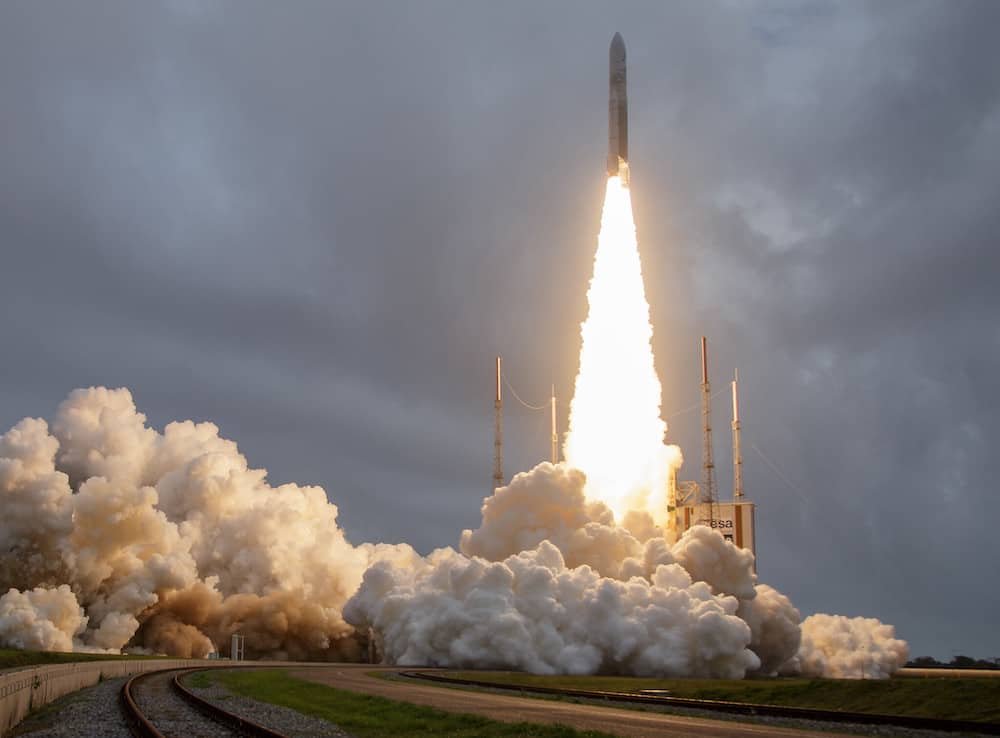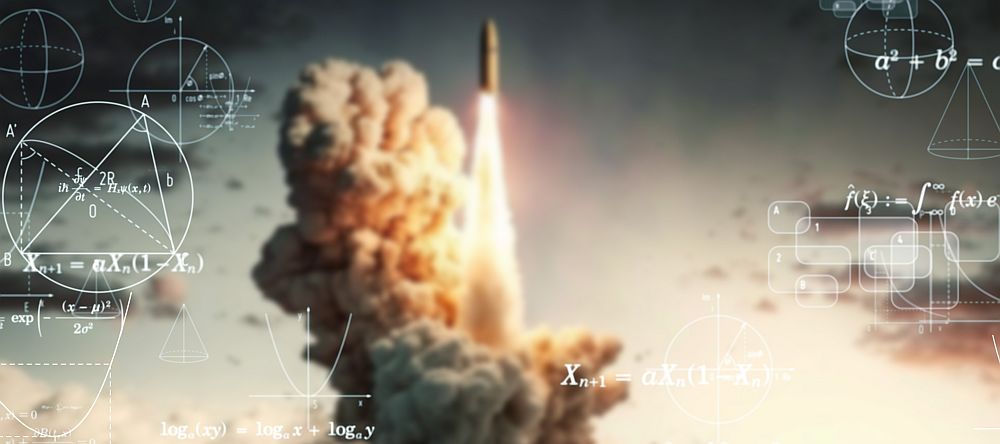
[Image above] Dec. 25, 2021: Arianespace’s Ariane 5 rocket launches with NASA’s James Webb Space Telescope onboard from the ELA-3 Launch Zone of Europe’s Spaceport at the Guiana Space Centre in Kourou, French Guiana. Credit: NASA’s James Webb Space Telescope, Flickr (CC BY 2.0)
On Dec. 25, 2021, astronomers received a Christmas gift that was three decades in the making—the launch of the James Webb Space Telescope (JWST).
JWST is NASA’s latest flagship mission, developed with contributions from the European Space Agency and the Canadian Space Agency. Intended to succeed the Hubble Space Telescope, JWST features improved infrared resolution to seek light from the first galaxies in the early universe and to explore our own solar system, as well as planets orbiting other stars. Learn more about JWST’s capabilities in the video below.

Credit: Perception, YouTube
While JWST represents a technological marvel, it also is a case study in project mismanagement. Today we’ll look at JWST’s 30-year journey to launch and ways that NASA could restructure its approach to large-scale projects in the future.
1990s—Start of an idea
When the Hubble Space Telescope launched in 1990, scientists hailed it as the dawn of a new age for astronomy and astrophysics. Yet even before the launch, astronomers were planning for what would come next, as explained on the James Webb Space Telescope website.
In September 1989, the Space Telescope Science Institute and NASA co-hosted the Next Generation Space Telescope Workshop. The workshop, which brought together more than 130 astronomers and engineers, discussed the science drivers and technical capabilities of a follow-up telescope to Hubble, which was then estimated to reach end-of-use in 2005.
In September 1993, the Association of Universities for Research in Astronomy, at the behest of the Space Telescope Institute Council and with support from NASA, appointed the Hubble Space Telescope & Beyond Committee. The committee was tasked to study possible missions and programs for ultraviolet optical infrared astronomy in space.
In 1996, the 18-member committee released a report formally recommending that NASA develop an infrared light-based space telescope (and that Hubble be operated beyond its original termination in 2005).
Following the report, three teams consisting of private and public sector scientists and engineers met to determine whether NASA could realize the committee’s vision. All three concluded that the proposed telescope would work, so in 1997 NASA agreed to fund additional studies on the technical and financial requirements for building the telescope.
2000s—3, 2, 1…delay
By 2002, NASA had selected teams to build the instruments and a group of astronomers to provide construction guidance for the telescope. The telescope also received its formal name of the James Webb Space Telescope, after the NASA administrator who led development of the Apollo program in the 1960s.
(In 2021, NASA considered renaming the telescope after a petition signed by more than 1,200 people requested a change in light of allegations that Webb was involved in persecuting gay and lesbian people during his career in government. After an investigation, NASA declined to rename the telescope.)
Construction on JWST began in 2004. In 2005, an Ariane 5 rocket was chosen as the launch vehicle, and the European Space Agency’s Centre Spatial Guyanais spaceport in French Guiana was chosen as the launch site.
Despite this initial progress, JWST development soon slowed down immensely due to technical and management challenges, contractor performance issues, and low levels of cost reserve. As a result, NASA moved the original launch date of 2007 to the early 2010s and increased the project’s cost estimate considerably—from $500 million estimated in 1996, to $1–3.5 billion estimated in 2002, to $5 billion estimated in 2008.
That’s when Congress started taking a closer look at how the project was being managed.
Congress scrutinizes JWST project management
As outlined in a Space News article, Congress first strongly confronted NASA about JWST’s swelling costs and delays during the fiscal year 2012 budget cycle deliberations.
In July 2011, appropriators in the Republican-controlled House passed a spending bill that would have canceled the JWST project. In the Senate, where Democrats had a majority, appropriators insisted on funding the project fully.
JWST was eventually funded, but the project went through an extensive replan that involved setting a new launch date for 2018 and capping the cost at $8 billion. However, NASA did not meet these new targets either.
In September 2017, NASA announced it would delay launch until spring 2019. Then in March 2018, it pushed the launch until spring 2020 and raised the cost estimate to $8.8 billion, with an extra $837 million requested for operating the telescope once it was in space. Finally, in June 2018, NASA moved the launch date to March 2021.
In July 2018, the House Science Committee held a two-day hearing to investigate the recent delays that caused JWST to breach its statutory cap on development costs once again. Then House Science Committee Chair Lamar Smith (R-TX) opened the hearing by censuring NASA’s handling of the project.
“It is truly staggering to behold how this space telescope’s cost and schedule projections went from costing the same as a space shuttle mission—around half a billion dollars with an original launch date in 2007—to now becoming an expenditure exceeding $9 billion with a new launch goal in March 2021. This is 19 times the original cost and a delay of 14 years. It doesn’t get much worse than that,” he said.
During the hearing, congresspeople heavily debated Northrop Grumman’s role in the delays. Since 2002, when Northrop Grumman acquired TRW Inc., the corporation that helped design JWST, Northrop Grumman became the prime constructor of JWST.
While errors are expected for a project as complex as JWST, independent reviews determined that the errors made under Northrop Grumman’s watch were avoidable.
“Workers used the wrong solvent to clean the observatory’s propulsion valves. A wiring error severely damaged the spacecraft’s pressure transducers. During an important test, the fasteners designed to hold the sun shield together came loose, scattering dozens of bolts that took months to find. These mistakes alone resulted in a schedule delay of about 1.5 years and $600 million,” an article on The Atlantic explains.
When congresspeople tried to hold Northrop Grumman accountable during the hearing, the company skirted answering if it should be responsible for covering the cost overruns, as detailed in an FYI article.
Instead, the focus became how NASA could improve the structure of its contracts and the bidding process. For example, retired aerospace executive Tom Young suggested that instead of NASA entertaining bids offering a “lowest credible cost,” NASA should establish a “most probable cost” before inviting bids and set criteria for awarding contracts to attract bids that emphasize good performance.
Two years after the House hearing, NASA announced another delay in July 2020, pushing the launch date to October 2021 due to the COVID-19 pandemic. In September 2021, the launch was delayed slightly more to December. Finally, on Dec. 25, 2021, JWST launched into space—more than 30 years after it was initially conceived and at a cost of $10 billion.
(NASA also returned the Hubble Space Telescope to full science operations in December 2021. This telescope, which JWST was meant to replace, has been operating now for more than 31 years.)
Visit news9live.com for a more detailed timeline of JWST project development.

Credit: James Webb Space Telescope (JWST), YouTube
The future of and after JWST
Now that JWST is launched and what appears to be successfully deployed, what happens next? An Inverse article does a good job laying out what to expect over the next few months.
First, NASA needs to finish making some final adjustments to JWST’s mirrors. Once that is done, NASA will direct JWST to fly directly to Lagrangian point 2, a spot 1 million miles away where Earth and the sun’s gravity cancel out, allowing the telescope to orbit the sun with Earth permanently at its back. After reaching this point and following final alignment, JWST can start collecting data no sooner than mid-summer 2022.
As for future projects, a big concern for Congress is avoiding the effects that JWST’s delays and cost overruns had on other projects in NASA’s portfolio, such as the Laser Interferometer Space Antenna (LISA) and the Wide-Field Infrared Survey Telescope (WFIRST).
To avoid future flagship missions crowding out funding for other important projects, the National Academies’ latest astronomy and astrophysics decadal survey suggests implementing a new “Great Observatories Mission and Technologies Maturation Program.”
“The survey explains that flagship missions routinely have development timescales stretching multiple decades and that immaturity of their component technologies has in the past led to costly difficulties. ‘By investing more in the maturation process, NASA could develop missions to a level where there is significantly more confidence in the costs and requisite cost profiles before seeking congressional approval for the final implementation,’ it states,” an FYI article explains.
Author
Lisa McDonald
CTT Categories
- Aeronautics & Space
- Education
Related Posts
Ohio Creativity Trail: Heisey Glass Museum
January 13, 2026


